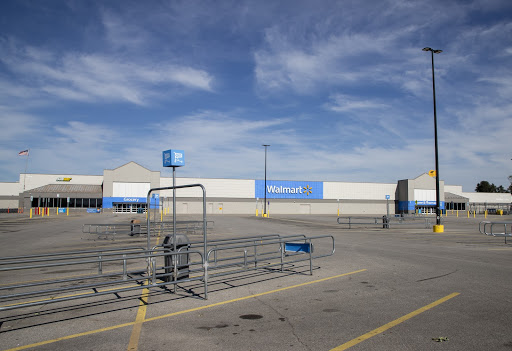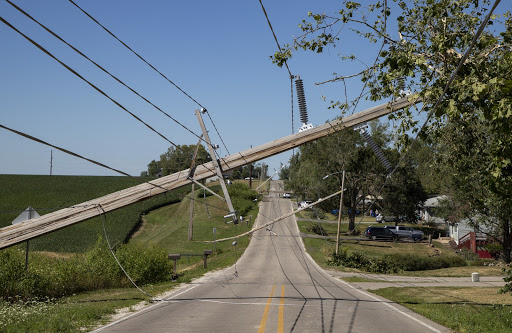Marshalltown hit hard by derecho just two years after catastrophic tornado

EMILY BARSKE Aug 12, 2020 | 8:53 pm
3 min read time
604 wordsAll Latest News, Arts and Culture, Energy, Statewide NewsTop: A rare sight, the Walmart parking lot sits empty in Marshalltown on Tuesday. Middle: Cars line Linn Street in Marshalltown, waiting to pump gas at one of the few open gas stations on Tuesday. A traffic director told those in line they were looking at a 1 hour and 40 minute waiting time. Bottom (below story): A power line hangs over Highland Acres Road in Marshalltown, blocking traffic from driving through. Photos by Emily Blobaum
The unknowing eye could drive through Marshalltown and assume the damaged buildings, mangled properties and broken tree limbs were from Monday’s derecho, which sent 99 mph winds through the city. But residents know that’s not the case. A little more than two years ago, the city was also hit with a catastrophic storm – that time an EF3 tornado – and residents are still in the midst of long-term recovery.
The city is in Marshall County, which is one of 20 counties under the state’s disaster proclamation, and is still almost entirely without power because of the severity of damage to electrical infrastructure. While some residents have power, it could be several days before others do.
“Just because your neighbor has power does not mean you will,” Marshall County Emergency Management Director Kim Elder told the Times-Republican. “It all depends on the system your house is connected to and how much damage you have. Getting the power back will not be consistent, such as block-to-block.”
On Tuesday, most businesses were closed. Of the three major grocery stores in town – Hy-Vee, Fareway and Walmart – only Hy-Vee was partially opened. Similarly, only a select number of gas stations were open, and late afternoon one traffic director said some people in line would have to wait 1 hour and 40 minutes to pump gas.
City officials have said while the damage is similar to the July 2018 tornado, it’s much more widespread this time rather than just the Main Street district (every Main Street business had some sort of tornado damage) and the north side. Some of the damage inflicted Monday was on buildings that already had damage or had recovered, while other areas of town that were previously untouched face severe damage.
Josh Gaul, managing attorney with Iowa Legal Aid, said there are many similarities to the 2018 storm and there is always an arc of legal issues when it comes to disaster recovery – especially for those who are uninsured or impoverished.
“It’s important for people to document their damages now in case there are other resources that come available down the road, whether that’s from state or federal resources. You might be able to show what your damages were with pictures or receipts,” he said.
Some of the most common legal issues in disaster recovery are insurance appeals, lost identification documents, contractor fraud or nuisance charges related to not having properties cleaned up, Gaul said.
The Iowa Individual Assistance Grant Program provides grants of up to $5,000 for households with incomes up to 200% of the federal poverty level, or a maximum annual income of $43,440 for a family of three. Grants are available for home or car repairs, replacement of clothing or food, and temporary housing expenses. The state also has a Disaster Case Management program to address serious needs to overcome a disaster-related hardship, injury or adverse condition.
Undocumented immigrants are not eligible for many government assistance programs. Individuals can still seek help through organizations like Iowa Justice For Our Neighbors.
Residents in communities facing storm damage are encouraged to contact local community action associations. You can contact Iowa Legal Aid at 800-532-1275 or www.iowalegalaid.org.













